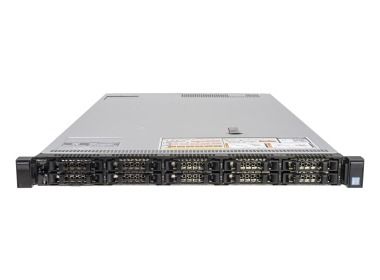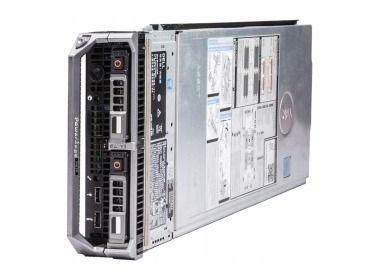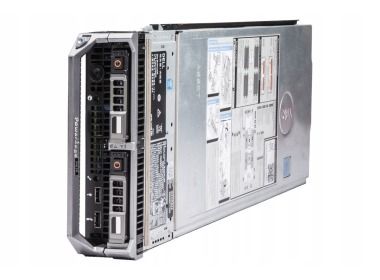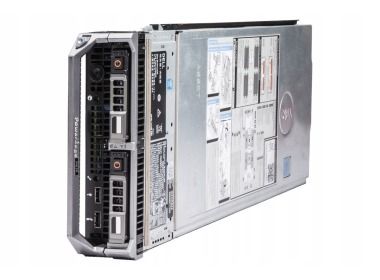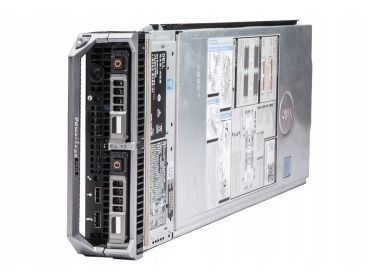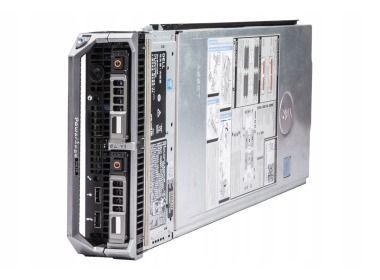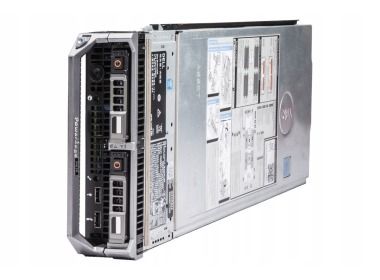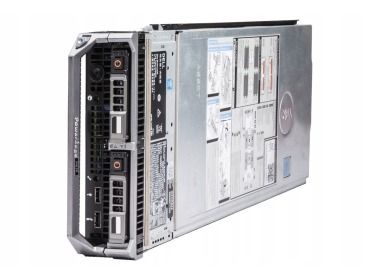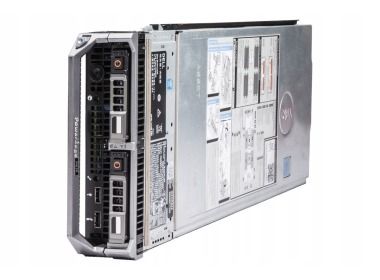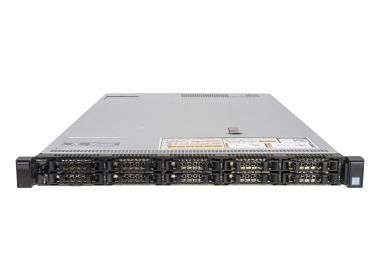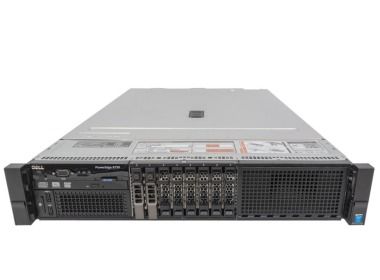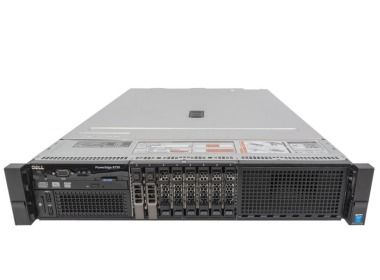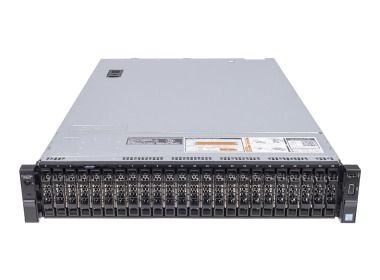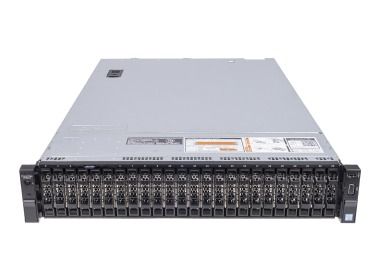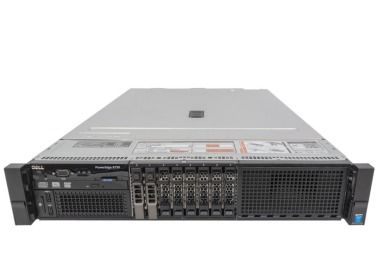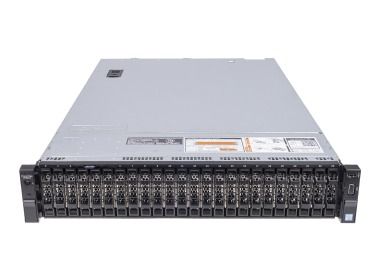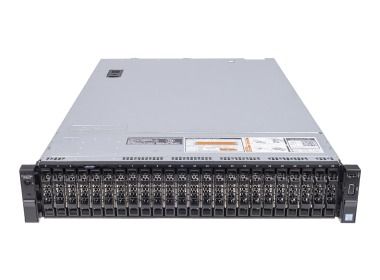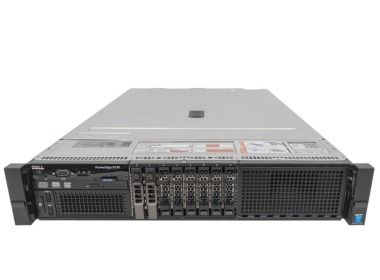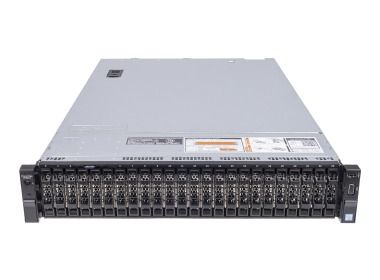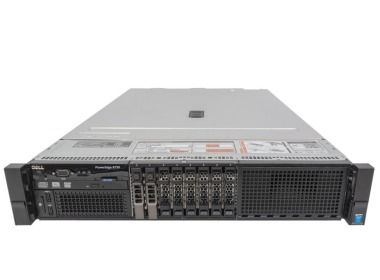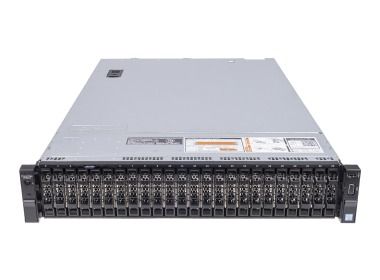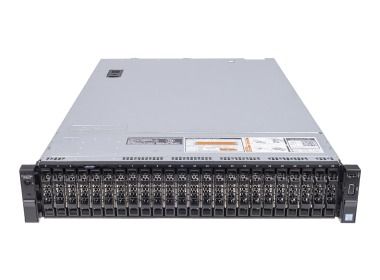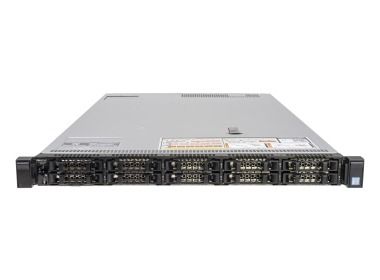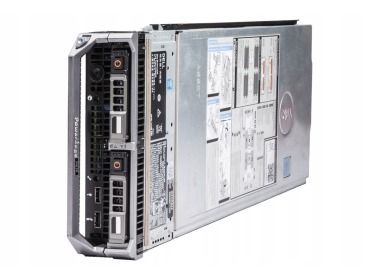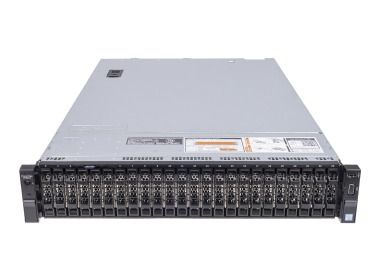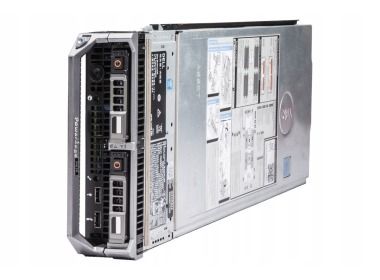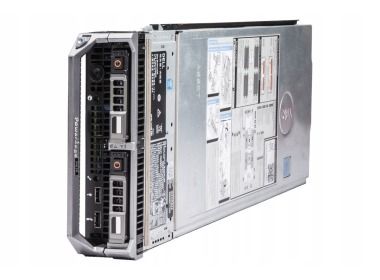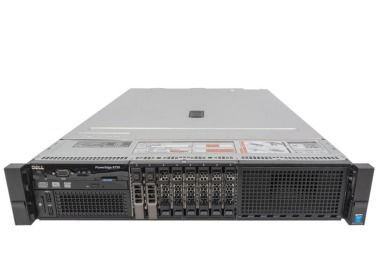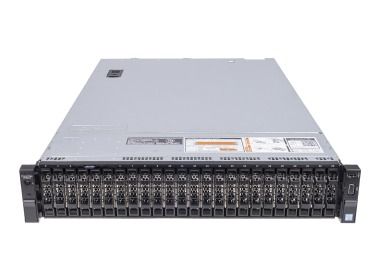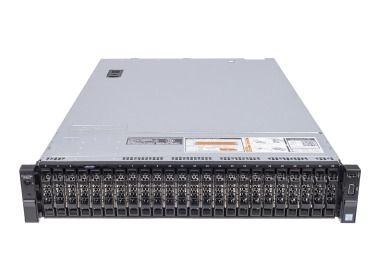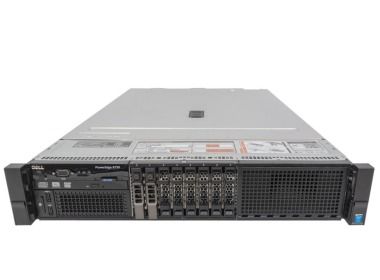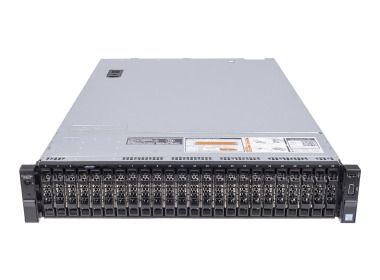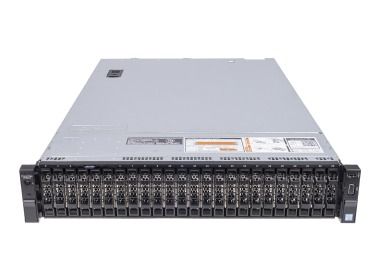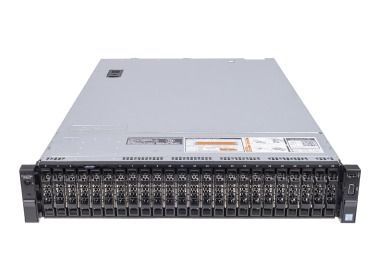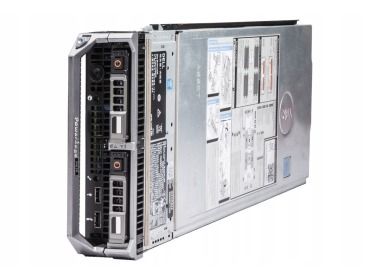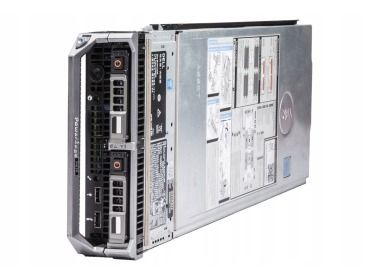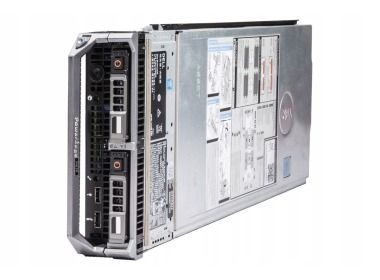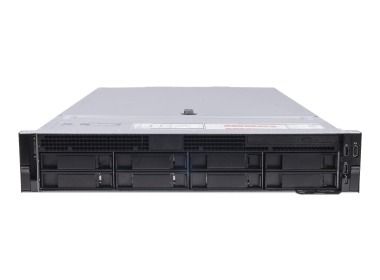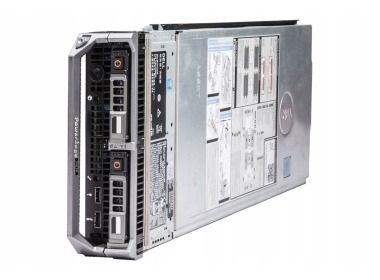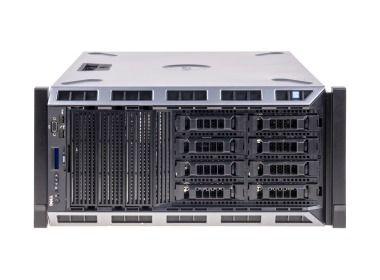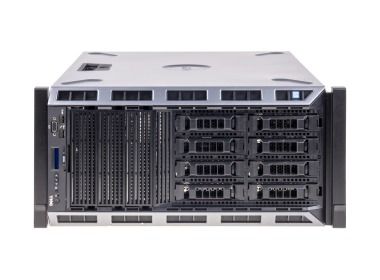- Server Dell PowerEdge R630 10x2.5" with 2xE5-2650 v3, 64GB, H730, 4x1GbE, 2xPSU, iDRAC 8 EnterpriseThe set includes: 1x Dell PowerEdge R630 10x2.5" server platform 2x Intel Xeon E5-2650 v3 10-core 2.3GHz 25MB 105W SR1YA processor 4x RAM 16GB 2133MHz DDR...Calculating delivery time...In stock 3Warranty 36 monthsPLN 1,330.00 PLN 1,081.30
- Server Dell M630 2x2.5" 2xE5-2620 v3, 32GB, H730, 2x480GB SSD SATA 2.5", 4x1GbE BNDC1x Dell M630 2x2.5" server platform 2x Intel Xeon E5-2620 v3 6-core 2.4GHz 15MB 85W SR207 processor 2x RAM 16GB 2133MHz DDR4 RDIMM 2x 480GB SSD SATA 2.5&q...Calculating delivery time...In stock 2Warranty 36 monthsPLN 1,980.00 PLN 1,609.76
- Server Dell M630 2x2.5" 2xE5-2680 v3, 32GB, H730, 2x480GB SSD SATA 2.5", 4x1GbE BNDC1x Dell M630 2x2.5" server platform 2x Intel Xeon E5-2680 v3 12-core 2.5GHz 30MB 120W SR1XP processor 2x RAM 16GB 2133MHz DDR4 RDIMM 2x 480GB SSD SATA 2.5...Calculating delivery time...In stock 2Warranty 36 monthsPLN 2,010.00 PLN 1,634.15
- Server Dell M630 2x2.5" 2xE5-2603 v3, 32GB, H730, 2x480GB SSD SATA 2.5", 4x1GbE BNDC1x Dell M630 2x2.5" server platform 2x Intel Xeon E5-2603 v3 6-core 1.6GHz 15MB 85W SR20A processor 2x RAM 16GB 2133MHz DDR4 RDIMM 2x 480GB SSD SATA 2.5&q...Calculating delivery time...In stock 2Warranty 36 monthsPLN 2,010.00 PLN 1,634.15
- Server Dell M630 2x2.5" 2xE5-2623 v4, 32GB, H730, 2x480GB SSD SATA 2.5", 4x1GbE BNDC1x Dell M630 2x2.5" server platform 2x Intel Xeon E5-2623 v4 4-core 2.6GHz 10MB 85W SR2PJ processor 2x RAM 16GB 2133MHz DDR4 RDIMM 2x 480GB SSD SATA 2.5&q...Calculating delivery time...In stock 2Warranty 36 monthsPLN 2,030.00 PLN 1,650.41
- Server Dell M630 2x2.5" 2xE5-2620 v4, 32GB, H730, 2x480GB SSD SATA 2.5", 4x1GbE BNDC1x Dell M630 2x2.5" server platform 2x Intel Xeon E5-2620 v4 8-core 2.1GHz 20MB 85W SR2R6 processor 2x RAM 16GB 2133MHz DDR4 RDIMM 2x 480GB SSD SATA 2.5&q...Calculating delivery time...In stock 2Warranty 36 monthsPLN 2,030.00 PLN 1,650.41
- Server Dell M630 2x2.5" 2xE5-2687W v3, 32GB, H730, 2x480GB SSD SATA 2.5", 4x1GbE BNDC1x Dell M630 2x2.5" server platform 2x Intel Xeon E5-2687W v3 10-core 3.1GHz 25MB 160W SR1Y6 processor 2x RAM 16GB 2133MHz DDR4 RDIMM 2x 480GB SSD SATA 2....Calculating delivery time...In stock 2Warranty 36 monthsPLN 2,220.00 PLN 1,804.88
- Server Dell M630 2x2.5" 2xE5-2690 v4, 32GB, H730, 2x480GB SSD SATA 2.5", 4x1GbE BNDC1x Dell M630 2x2.5" server platform 2x Intel Xeon E5-2690 v4 14-core 2.6GHz 35MB 135W SR2N2 processor 2x RAM 16GB 2400MHz DDR4 RDIMM 2x 480GB SSD SATA 2.5...Calculating delivery time...In stock 2Warranty 36 monthsPLN 2,350.00 PLN 1,910.57
- Server Dell M630 2x2.5" 2xE5-2667 v4, 32GB, H730, 2x480GB SSD SATA 2.5", 4x1GbE BNDC1x Dell M630 2x2.5" server platform 2x Intel Xeon E5-2667 v4 8-core 3.2GHz 25MB 135W SR2P5 processor 2x RAM 16GB 2400MHz DDR4 RDIMM 2x 480GB SSD SATA 2.5&...Calculating delivery time...In stock 2Warranty 36 monthsPLN 2,410.00 PLN 1,959.35
- Server Dell R630 10x2.5” with 2xE5-2620 v3, 128GB RAM, H730, 8x1TB SATA 7.2K 2.5”, 4x1GbE, 2xPSU, Rails, iDRAC 8 EnterpriseThe set includes: 2x Heatsink Dell PowerEdge R630 1x Kontroler RAID Dell H730 1GB Adapter PCI-E 3.0x8 2xSFF-8643 wewnętrzne 12Gb SAS 6Gb SATA 44GNF 1x Obudowa...Calculating delivery time...In stock 1Warranty 36 monthsPLN 2,550.00 PLN 2,073.17
- Server Dell PowerEdge R730xd 24x2.5" with 2x E5-2640 v4, 32GB RAM, H730, 2x480GB SSD SATA 2.5", 4x1GbE, 2xPSU, Rails, iDRAC 8 Enterprise1x Dell PowerEdge R730xd 24x2.5" server platform 1x Intel Xeon E5-2640 v4 10-core 2.4GHz 25MB 90W SR2NZ processor 2x RAM 16GB 2133MHz DDR4 RDIMM 2x 480GB ...Calculating delivery time...In stock 3Warranty 36 monthsPLN 2,575.01 PLN 2,093.50
- Server Dell PowerEdge R730 8x2.5" with 2x E5-2637 v3, 32GB RAM, 2x 960GB SSD SATA 2.5", 4x1GbE RJ45, 2x PSU, rails, iDRAC 8This set contains: 1x Dell PowerEdge R730 8x2.5" server platform 2x Intel Xeon E5-2637 v3 4-core 3.5GHz 15MB 135W SR202 processor 2x RAM 16GB 2133MHz DDR4...Calculating delivery time...In stock 3Warranty 36 monthsPLN 2,575.01 PLN 2,093.50
- Server Dell R730 8x2.5" with 2xE5-2660 v3, 32GB RAM, H730, 2x 960GB SSD SATA 2.5", 4x1GbE, 2xPSU, Rails, iDRAC 8 EnterpriseThis set contains: 1x Dell PowerEdge R730 8x2.5" server platform 2x Intel Xeon E5-2660 v3 10-core 2.6GHz 25MB 105W SR1XR processor 2x RAM 16GB 2133MHz DDR...Calculating delivery time...In stock 3Warranty 36 monthsPLN 2,575.01 PLN 2,093.50
- Server Dell PowerEdge R730xd 24x2.5" with 2x E5-2660 v3, 32GB RAM, H730, 2x480GB SSD SATA 2.5", 4x1GbE, 2xPSU, Rails, iDRAC 8 Enterprise1x Dell PowerEdge R730xd 24x2.5" server platform 2x Intel Xeon E5-2660 v3 10-core 2.6GHz 25MB 105W SR1XR processor 2x RAM 16GB 2133MHz DDR4 RDIMM 2x 480GB...Calculating delivery time...In stock 3Warranty 36 monthsPLN 2,600.00 PLN 2,113.82
- Server Dell PowerEdge R730xd 24x2.5" with 2x E5-2637 v3, 32GB RAM, H730, 2x480GB SSD SATA 2.5", 4x1GbE, 2xPSU, Rails, iDRAC 8 Enterprise1x Dell PowerEdge R730xd 24x2.5" server platform 2x Intel Xeon E5-2637 v3 4-core 3.5GHz 15MB 135W SR202 processor 2x RAM 16GB 2133MHz DDR4 RDIMM 2x 480GB ...Calculating delivery time...In stock 3Warranty 36 monthsPLN 2,600.00 PLN 2,113.82
- Server Dell R730 8x2.5" with 2xE5-2640 v4, 32GB RAM, H730, 2x 960GB SSD SATA 2.5", 4x1GbE, 2xPSU, Rails, iDRAC 8 EnterpriseThis set contains: 1x Dell PowerEdge R730 8x2.5" server platform 2x Intel Xeon E5-2640 v4 10-core 2.4GHz 25MB 90W SR2NZ processor 2x RAM 16GB 2133MHz DDR4...Calculating delivery time...In stock 3Warranty 36 monthsPLN 2,600.00 PLN 2,113.82
- Server Dell PowerEdge R730 8x2.5" with 2x E5-2630 v4, 32GB RAM, 2x 960GB SSD SATA 2.5", 4x1GbE RJ45, 2x PSU, rails, iDRAC 8This set contains: 1x Dell PowerEdge R730 8x2.5" server platform 2x Intel Xeon E5-2630 v4 10-core 2.2GHz 25MB 85W SR2R7 processor 2x RAM 16GB 2133MHz DDR4...Calculating delivery time...In stock 3Warranty 36 monthsPLN 2,650.00 PLN 2,154.47
- Server Dell PowerEdge R730xd 24x2.5" with 2x E5-2640 v3, 32GB RAM, H730, 2x480GB SSD SATA 2.5", 4x1GbE, 2xPSU, Rails, iDRAC 8 Enterprise1x Dell PowerEdge R730xd 24x2.5" server platform 2x Intel Xeon E5-2640 v3 8-core 2.6GHz 20MB 90W SR205 processor 2x RAM 16GB 2133MHz DDR4 RDIMM 2x 480GB S...Calculating delivery time...In stock 9Warranty 36 monthsPLN 2,650.00 PLN 2,154.47
- Server Dell PowerEdge R730xd 24x2.5" with 2x E5-2630v4, 32GB RAM, H730, 2x480GB SSD SATA 2.5", 4x1GbE, 2xPSU, Rails, iDRAC 8 Enterprise1x Dell PowerEdge R730xd 24x2.5" server platform 2x Intel Xeon E5-2630 v4 10-core 2.2GHz 25MB 85W SR2R7 processor 2x RAM 16GB 2133MHz DDR4 RDIMM 2x 480GB ...Calculating delivery time...In stock 6Warranty 36 monthsPLN 2,675.00 PLN 2,174.80
- Server Dell PowerEdge R630 10x2.5" with 2x E5-2667 v3, 128GB RAM, 2x 480GB SSD SATA 2.5", 2x1GbE RJ45 2x10GbE SFP+, 2x PSU, Rails, iDRAC 8The set includes: 1x Dell PowerEdge R630 10x2.5" server platform 2x Intel Xeon E5-2667 v3 8-core 3.2GHz 20MB 135W SR203 processor 8x RAM 16GB 2133MHz DDR4...Calculating delivery time...Warranty 36 monthsPLN 2,725.00 PLN 2,215.45
- Server Dell PowerEdge R730xd 24x2.5" with 2x E5-2660 v3, 64GB RAM, H730, 2x480GB SSD SATA 2.5", 4x1GbE, 2xPSU, Rails, iDRAC 8 Enterprise1x Dell PowerEdge R730xd 24x2.5" server platform 2x Intel Xeon E5-2660 v3 10-core 2.6GHz 25MB 105W SR1XR processor 4x RAM 16GB 2133MHz DDR4 RDIMM 2x 480GB...Calculating delivery time...In stock 3Warranty 36 monthsPLN 2,750.00 PLN 2,235.77
- Server Dell PowerEdge R730xd 24x2.5" with 2x E5-2640 v4, 64GB RAM, H730, 2x480GB SSD SATA 2.5", 4x1GbE, 2xPSU, Rails, iDRAC 8 Enterprise1x Dell PowerEdge R730xd 24x2.5" server platform 1x Intel Xeon E5-2640 v4 10-core 2.4GHz 25MB 90W SR2NZ processor 4x RAM 16GB 2133MHz DDR4 RDIMM 2x 480GB ...Calculating delivery time...In stock 3Warranty 36 monthsPLN 2,750.00 PLN 2,235.77
- Server Dell PowerEdge R730 8x2.5" with 2x E5-2637 v3, 64GB RAM, 2x 960GB SSD SATA 2.5", 4x1GbE RJ45, 2x PSU, rails, iDRAC 8This set contains: 1x Dell PowerEdge R730 8x2.5" server platform 2x Intel Xeon E5-2637 v3 4-core 3.5GHz 15MB 135W SR202 processor 4x RAM 16GB 2133MHz DDR4...Calculating delivery time...In stock 3Warranty 36 monthsPLN 2,750.00 PLN 2,235.77
- Server Dell R730 8x2.5" with 2xE5-2640 v4, 64GB RAM, H730, 2x 960GB SSD SATA 2.5", 4x1GbE, 2xPSU, Rails, iDRAC 8 EnterpriseThis set contains: 1x Dell PowerEdge R730 8x2.5" server platform 2x Intel Xeon E5-2640 v4 10-core 2.4GHz 25MB 90W SR2NZ processor 4x RAM 16GB 2133MHz DDR4...Calculating delivery time...In stock 3Warranty 36 monthsPLN 2,750.00 PLN 2,235.77
- Server Dell PowerEdge R730xd 24x2.5" with 2x E5-2637 v3, 64GB RAM, H730, 2x480GB SSD SATA 2.5", 4x1GbE, 2xPSU, Rails, iDRAC 8 Enterprise1x Dell PowerEdge R730xd 24x2.5" server platform 2x Intel Xeon E5-2637 v3 4-core 3.5GHz 15MB 135W SR202 processor 4x RAM 16GB 2133MHz DDR4 RDIMM 2x 480GB ...Calculating delivery time...In stock 3Warranty 36 monthsPLN 2,775.00 PLN 2,256.10
- Server Dell PowerEdge R730 8x2.5" with 2x E5-2630 v4, 64GB RAM, 2x 960GB SSD SATA 2.5", 4x1GbE RJ45, 2x PSU, rails, iDRAC 8This set contains: 1x Dell PowerEdge R730 8x2.5" server platform 2x Intel Xeon E5-2630 v4 10-core 2.2GHz 25MB 85W SR2R7 processor 4x RAM 16GB 2133MHz DDR4...Calculating delivery time...In stock 3Warranty 36 monthsPLN 2,800.00 PLN 2,276.42
- Server Dell PowerEdge R730xd 24x2.5" with 2x E5-2640 v3, 64GB RAM, H730, 2x480GB SSD SATA 2.5", 4x1GbE, 2xPSU, Rails, iDRAC 8 Enterprise1x Dell PowerEdge R730xd 24x2.5" server platform 2x Intel Xeon E5-2640 v3 8-core 2.6GHz 20MB 90W SR205 processor 4x RAM 16GB 2133MHz DDR4 RDIMM 2x 480GB S...Calculating delivery time...In stock 5Warranty 36 monthsPLN 2,800.00 PLN 2,276.42
- Server Dell PowerEdge R730xd 24x2.5" with 2x E5-2630v4, 64GB RAM, H730, 2x480GB SSD SATA 2.5", 4x1GbE, 2xPSU, Rails, iDRAC 8 Enterprise1x Dell PowerEdge R730xd 24x2.5" server platform 2x Intel Xeon E5-2630 v4 10-core 2.2GHz 25MB 85W SR2R7 processor 4x RAM 16GB 2133MHz DDR4 RDIMM 2x 480GB ...Calculating delivery time...In stock 5Warranty 36 monthsPLN 2,825.00 PLN 2,296.75
- Server Dell PowerEdge R630 10x2.5" with 2x E5-2687W v3, 128GB RAM, 2x 960GB SSD SATA 2.5", 2x1GbE RJ45 2x10GbE BASE-T, 2x PSU, Rails, iDRAC 8The set includes: 1x Platforma serwerowa Dell PowerEdge R630 10x2.5" 2x Procesor Intel Xeon E5-2687W v3 10-core 3.1GHz 25MB 160W SR1Y6 8x Pamięć RAM 16G...Calculating delivery time...In stock 6Warranty 36 monthsPLN 2,999.99 PLN 2,439.02
- Server Dell M630 2x2.5" 2xE5-2620 v3, 32GB, H730, 2x480GB SSD SATA 2.5", 2x PCI-BRIDGE1x Dell M630 2x2.5" server platform 2x Intel Xeon E5-2620 v3 6-core 2.4GHz 15MB 85W SR207 processor 2x RAM 16GB 2133MHz DDR4 RDIMM 2x 480GB SSD SATA 2.5&q...Calculating delivery time...In stock 2Warranty 36 monthsPLN 2,999.99 PLN 2,439.02
- Server Dell M630 2x2.5" 2xE5-2680 v3, 32GB, H730, 2x480GB SSD SATA 2.5", 2x PCI-BRIDGE1x Dell M630 2x2.5" server platform 2x Intel Xeon E5-2680 v3 12-core 2.5GHz 30MB 120W SR1XP processor 2x RAM 16GB 2133MHz DDR4 RDIMM 2x 480GB SSD SATA 2.5...Calculating delivery time...In stock 2Warranty 36 monthsPLN 3,025.00 PLN 2,459.35
- Server Dell M630 2x2.5" 2xE5-2603 v3, 32GB, H730, 2x480GB SSD SATA 2.5", 2x PCI-BRIDGE1x Dell M630 2x2.5" server platform 2x Intel Xeon E5-2603 v3 6-core 1.6GHz 15MB 85W SR20A processor 2x RAM 16GB 2133MHz DDR4 RDIMM 2x 480GB SSD SATA 2.5&q...Calculating delivery time...In stock 2Warranty 36 monthsPLN 3,025.00 PLN 2,459.35
- Server Dell PowerEdge R730xd 24x2.5" with 2x E5-2640 v4, 128GB RAM, H730, 2x480GB SSD SATA 2.5", 4x1GbE, 2xPSU, Rails, iDRAC 8 Enterprise1x Dell PowerEdge R730xd 24x2.5" server platform 1x Intel Xeon E5-2640 v4 10-core 2.4GHz 25MB 90W SR2NZ processor 8x RAM 16GB 2133MHz DDR4 RDIMM 2x 480GB ...Calculating delivery time...In stock 3Warranty 36 monthsPLN 3,049.99 PLN 2,479.67
- Server Dell M630 2x2.5" 2xE5-2623 v4, 32GB, H730, 2x480GB SSD SATA 2.5", 2x PCI-BRIDGE1x Dell M630 2x2.5" server platform 2x Intel Xeon E5-2623 v4 4-core 2.6GHz 10MB 85W SR2PJ processor 2x RAM 16GB 2133MHz DDR4 RDIMM 2x 480GB SSD SATA 2.5&q...Calculating delivery time...In stock 2Warranty 36 monthsPLN 3,049.99 PLN 2,479.67
- Server Dell M630 2x2.5" 2xE5-2620 v4, 32GB, H730, 2x480GB SSD SATA 2.5", 2x PCI-BRIDGE1x Dell M630 2x2.5" server platform 2x Intel Xeon E5-2620 v4 8-core 2.1GHz 20MB 85W SR2R6 processor 2x RAM 16GB 2133MHz DDR4 RDIMM 2x 480GB SSD SATA 2.5&q...Calculating delivery time...In stock 2Warranty 36 monthsPLN 3,049.99 PLN 2,479.67
- Server Dell R730 8x2.5" with 2xE5-2660 v3, 128GB RAM, H730, 2x 960GB SSD SATA 2.5", 4x1GbE, 2xPSU, Rails, iDRAC 8 EnterpriseThis set contains: 1x Dell PowerEdge R730 8x2.5" server platform 2x Intel Xeon E5-2660 v3 10-core 2.6GHz 25MB 105W SR1XR processor 8x RAM 16GB 2133MHz DDR...Calculating delivery time...In stock 3Warranty 36 monthsPLN 3,049.99 PLN 2,479.67
- Server Dell PowerEdge R730xd 24x2.5" with 2x E5-2699 v3, 32GB RAM, H730, 2x480GB SSD SATA 2.5", 4x1GbE, 2xPSU, Rails, iDRAC 8 Enterprise1x Dell PowerEdge R730xd 24x2.5" server platform 2x Intel Xeon E5-2699 v3 18-core 2.3GHz 45MB 145W SR1XD processor 2x RAM 16GB 2133MHz DDR4 RDIMM 2x 480GB...Calculating delivery time...In stock 3Warranty 36 monthsPLN 3,075.00 PLN 2,500.00
- Server Dell PowerEdge R730xd 24x2.5" with 2x E5-2660 v3, 128GB RAM, H730, 2x480GB SSD SATA 2.5", 4x1GbE, 2xPSU, Rails, iDRAC 8 Enterprise1x Dell PowerEdge R730xd 24x2.5" server platform 2x Intel Xeon E5-2660 v3 10-core 2.6GHz 25MB 105W SR1XR processor 8x RAM 16GB 2133MHz DDR4 RDIMM 2x 480GB...Calculating delivery time...In stock 3Warranty 36 monthsPLN 3,075.00 PLN 2,500.00
- Server Dell PowerEdge R240 4x3.5" with 1x E-2124, 16GB RAM, H330, 2x 1TB SATA 7.2K 3.5", 1xPSU, iDRAC 9 Enterprise1x Dell PowerEdge R240 4x3.5" server platform 1x Intel Xeon E-2124 4-core 3.3GHz 8MB 71W SR3WQ processor 1x RAM 16GB 2666MHz DDR4 UDIMM ECC 2x 1TB 7.2K SA...Calculating delivery time...In stock 1Warranty 36 monthsPLN 3,075.00 PLN 2,500.00
- Server Dell R730 8x2.5" with 2xE5-2640 v4, 128GB RAM, H730, 2x 960GB SSD SATA 2.5", 4x1GbE, 2xPSU, Rails, iDRAC 8 EnterpriseThis set contains: 1x Dell PowerEdge R730 8x2.5" server platform 2x Intel Xeon E5-2640 v4 10-core 2.4GHz 25MB 90W SR2NZ processor 8x RAM 16GB 2133MHz DDR4...Calculating delivery time...In stock 3Warranty 36 monthsPLN 3,075.00 PLN 2,500.00
- Server Dell PowerEdge R730xd 24x2.5" with 2x E5-2637 v3, 128GB RAM, H730, 2x480GB SSD SATA 2.5", 4x1GbE, 2xPSU, Rails, iDRAC 8 Enterprise1x Dell PowerEdge R730xd 24x2.5" server platform 2x Intel Xeon E5-2637 v3 4-core 3.5GHz 15MB 135W SR202 processor 8x RAM 16GB 2133MHz DDR4 RDIMM 2x 480GB ...Calculating delivery time...In stock 3Warranty 36 monthsPLN 3,100.01 PLN 2,520.33
- Server Dell PowerEdge R730xd 24x2.5" with 2x E5-2640 v3, 128GB RAM, H730, 2x480GB SSD SATA 2.5", 4x1GbE, 2xPSU, Rails, iDRAC 8 Enterprise1x Dell PowerEdge R730xd 24x2.5" server platform 2x Intel Xeon E5-2640 v3 8-core 2.6GHz 20MB 90W SR205 processor 8x RAM 16GB 2133MHz DDR4 RDIMM 2x 480GB S...Calculating delivery time...In stock 3Warranty 36 monthsPLN 3,125.00 PLN 2,540.65
- Server Dell PowerEdge R730xd 24x2.5" with 2x E5-2630v4, 128GB RAM, H730, 2x480GB SSD SATA 2.5", 4x1GbE, 2xPSU, Rails, iDRAC 8 Enterprise1x Dell PowerEdge R730xd 24x2.5" server platform 2x Intel Xeon E5-2630 v4 10-core 2.2GHz 25MB 85W SR2R7 processor 8x RAM 16GB 2133MHz DDR4 RDIMM 2x 480GB ...Calculating delivery time...In stock 3Warranty 36 monthsPLN 3,150.01 PLN 2,560.98
- Server Dell PowerEdge M630 2x2.5" with 2x E5-2630 v3, 32GB RAM, 2x 480GB SSD SATA 2.5", 2x PCI-BRIDGE1x Dell M630 2x2.5" server platform 2x Intel Xeon E5-2630 v3 8-core 2.4GHz 20MB 85W SR206 processor 2x RAM 16GB 2133MHz DDR4 RDIMM 2x 480GB SSD SATA 2.5&q...Calculating delivery time...In stock 2Warranty 36 monthsPLN 3,175.00 PLN 2,581.30
- Server Dell PowerEdge R730xd 24x2.5" with 2x E5-2699 v3, 64GB RAM, H730, 2x480GB SSD SATA 2.5", 4x1GbE, 2xPSU, Rails, iDRAC 8 Enterprise1x Dell PowerEdge R730xd 24x2.5" server platform 2x Intel Xeon E5-2699 v3 18-core 2.3GHz 45MB 145W SR1XD processor 4x RAM 16GB 2133MHz DDR4 RDIMM 2x 480GB...Calculating delivery time...In stock 3Warranty 36 monthsPLN 3,250.00 PLN 2,642.28
- Server Dell M630 2x2.5" 2xE5-2687W v3, 32GB, H730, 2x480GB SSD SATA 2.5", 2x PCI-BRIDGE1x Dell M630 2x2.5" server platform 2x Intel Xeon E5-2687W v3 10-core 3.1GHz 25MB 160W SR1Y6 processor 2x RAM 16GB 2133MHz DDR4 RDIMM 2x 480GB SSD SATA 2....Calculating delivery time...In stock 2Warranty 36 monthsPLN 3,250.00 PLN 2,642.28
- Server Dell M630 2x2.5" 2xE5-2690 v4, 32GB, H730, 2x480GB SSD SATA 2.5", 2x PCI-BRIDGE1x Dell M630 2x2.5" server platform 2x Intel Xeon E5-2690 v4 14-core 2.6GHz 35MB 135W SR2N2 processor 2x RAM 16GB 2400MHz DDR4 RDIMM 2x 480GB SSD SATA 2.5...Calculating delivery time...In stock 2Warranty 36 monthsPLN 3,375.00 PLN 2,743.90
- Server Dell M630 2x2.5" 2xE5-2628 v3, 32GB, H730, 2x480GB SSD SATA 2.5", 4x1GbE BNDC1x Dell M630 2x2.5" server platform 2x Intel Xeon E5-2628 v3 8-core 2.5GHz 20MB 85W SR201 processor 2x RAM 16GB 2133MHz DDR4 RDIMM 2x 480GB SSD SATA 2.5&q...Calculating delivery time...In stock 2Warranty 36 monthsPLN 3,400.00 PLN 2,764.23
- Server Dell M630 2x2.5" 2xE5-2667 v4, 32GB, H730, 2x480GB SSD SATA 2.5", 2x PCI-BRIDGE1x Dell M630 2x2.5" server platform 2x Intel Xeon E5-2667 v4 8-core 3.2GHz 25MB 135W SR2P5 processor 2x RAM 16GB 2400MHz DDR4 RDIMM 2x 480GB SSD SATA 2.5&...Calculating delivery time...In stock 2Warranty 36 monthsPLN 3,425.00 PLN 2,784.55
- Server Dell PowerEdge R740 8x3.5" with 1x Gold 6126, 16GB RAM, H730P, 4x1GbE, 2x PSU, iDRAC 9 EnterpriseThis set contains: 1x Dell PowerEdge R740 8x3.5" server platform 1x Intel Xeon Gold 6126 12-core 2.6GHz 19.25MB 125W SR3B3 processor 1x RAM 16GB DDR4 2666...Warranty 36 monthsPLN 3,500.00 PLN 2,845.53Out of stock
- Server HPE ProLiant DL380P 25x2.5" with 2xE5-2640, 32GB, P420, 2x960GB SSD SATA 2.5", 2x 2xPSU, Rails, iLO Advanced1x HPE ProLiant DL380P Gen8 25x2.5" server platform 2x Intel Xeon E5-2640 6-core 2.5GHz 15MB 95W SR0KR processor 2x HPE 960GB SSD SATA 2.5" hard driv...Calculating delivery time...In stock 1Warranty 36 monthsPLN 3,500.00 PLN 2,845.53
- Server Dell M630 2x2.5" 2x2687W v4, 32GB, H730, 2x480GB SSD SATA 2.5", 2x PCI-BRIDGE1x Dell M630 2x2.5" server platform 2x Intel Xeon E5-2687W v4 12-core 3GHz 30MB 160W SR2NA processor 2x RAM 16GB 2400MHz DDR4 RDIMM 2x 480GB SSD SATA 2.5&...Calculating delivery time...In stock 2Warranty 36 monthsPLN 3,525.00 PLN 2,865.85
- Server Dell PowerEdge R740 8x3.5" with 1x Gold 6126, 32GB RAM, H730P, 4x1GbE, 2x PSU, iDRAC 9 EnterpriseThis set contains: 1x Dell PowerEdge R740 8x3.5" server platform 1x Intel Xeon Gold 6126 12-core 2.6GHz 19.25MB 125W SR3B3 processor 2x RAM 16GB DDR4 2666...Warranty 36 monthsPLN 3,575.00 PLN 2,906.50Out of stock
- Server Dell M630 2x2.5" 2xE5-2650 v4, 128GB, H730, 2x800GB SSD SATA 2.5", 4x1GbE1x Dell M630 2x2.5" server platform 2x Intel Xeon E5-2650 v4 12-core 2.2GHz 30MB 105W SR2N3 processor 8x RAM 16GB 2133MHz DDR4 RDIMM 2x Dell 800GB SSD SAT...Calculating delivery time...In stock 2Warranty 36 monthsPLN 3,674.99 PLN 2,987.80
- Server Dell T430 8x3.5" with 2xE5-2620 v3, 32GB RAM, H330, 2x480GB SSD SATA, 2xPSU, Rails, iDRAC 8 Enterprise1x Dell PowerEdge T430 8x3.5" server platform 2x Intel Xeon E5-2620 v3 6-core 2.4GHz 15MB 85W SR207 processor 2x RAM 16GB 2133MHz DDR4 RDIMM 2x 480GB SSD ...Calculating delivery time...In stock 3Warranty 36 monthsPLN 4,300.01 PLN 3,495.94
- Server Dell T430 8x3.5" with 2xE5-2623 v3, 32GB RAM, H330, 2x480GB SSD SATA, 2xPSU, Rails, iDRAC 8 Enterprise1x Dell PowerEdge T430 8x3.5" server platform 2x Intel Xeon E5-2623 v3 4-core 3GHz 10MB 105W SR208 processor 2x RAM 16GB 2133MHz DDR4 RDIMM 2x 480GB SSD S...Calculating delivery time...In stock 3Warranty 36 monthsPLN 4,325.00 PLN 3,516.26
- Server Dell T430 8x3.5" with 2xE5-2680 v3, 32GB RAM, H330, 2x480GB SSD SATA, 2xPSU, Rails, iDRAC 8 Enterprise1x Dell PowerEdge T430 8x3.5" server platform 2x Intel Xeon E5-2680 v3 12-core 2.5GHz 30MB 120W SR1XP processor 2x RAM 16GB 2133MHz DDR4 RDIMM 2x 480GB SS...Calculating delivery time...In stock 3Warranty 36 monthsPLN 4,350.01 PLN 3,536.59
- Server Dell T430 8x3.5" with 2xE5-2660 v3, 32GB RAM, H330, 2x480GB SSD SATA, 2xPSU, Rails, iDRAC 8 Enterprise1x Dell PowerEdge T430 8x3.5" server platform 2x Intel Xeon E5-2660 v3 10-core 2.6GHz 25MB 105W SR1XR processor 2x RAM 16GB 2133MHz DDR4 RDIMM 2x 480GB SS...Calculating delivery time...In stock 3Warranty 36 monthsPLN 4,350.01 PLN 3,536.59
- Server Dell T430 8x3.5" with 2xE5-2637 v3, 32GB RAM, H330, 2x480GB SSD SATA, 2xPSU, Rails, iDRAC 8 Enterprise1x Dell PowerEdge T430 8x3.5" server platform 2x Intel Xeon E5-2637 v3 4-core 3.5GHz 15MB 135W SR202 processor 2x RAM 16GB 2133MHz DDR4 RDIMM 2x 480GB SSD...Calculating delivery time...In stock 3Warranty 36 monthsPLN 4,350.01 PLN 3,536.59
- Server Dell T430 8x3.5" with 2xE5-2620 v4, 32GB RAM, H330, 2x480GB SSD SATA, 2xPSU, Rails, iDRAC 8 Enterprise1x Dell PowerEdge T430 8x3.5" server platform 2x Intel Xeon E5-2620 v4 8-core 2.1GHz 20MB 85W SR2R6 processor 2x RAM 16GB 2133MHz DDR4 RDIMM 2x 480GB SSD ...Calculating delivery time...In stock 3Warranty 36 monthsPLN 4,350.01 PLN 3,536.59
Choosing the right server for Microsoft SQL Server isn't a matter of 'if', but 'how well' it performs. Database speed impacts not only user comfort but also the operation of critical systems – from ERP to analytics, from CRM to document archives. That's why this category exclusively features configurations genuinely proven as a solid foundation for SQL environments, catering to everything from smaller installations to advanced deployments handling dozens of active connections and large data volumes. If your system runs on SQL Server, this hardware was designed specifically for it.
Performance Where It Matters Most – CPU, RAM, and Storage Make the Difference
Servers dedicated to SQL Server must effectively combine computational power with the right memory and disk architecture. Consequently, most models in this category are based on dual-processor units from the Intel Xeon Silver, Gold, or E5 v3/v4 series, offering configurations with a total core count ranging from 8 up to 40 cores. A typical setup includes 64–128 GB of DDR4 ECC RAM, often expandable to 512 GB or more, depending on the specific model. Complementing this are fast 2.5" SATA SSDs or NVMe U.2 drives, installed in a RAID 1 or RAID 10 configuration – all implemented to ensure the database operates not only quickly but also securely. An appropriate SQL server is one that doesn't bog down under query load, doesn't hang during report generation, and safeguards data against power failures. Here, all components work in harmony.
Thoughtful Server Design = Fewer Operational Headaches
Models such as the Dell PowerEdge R630, R730xd, T630, or HPE DL360/380 Gen10 are not arbitrary selections; they represent hardware engineered for non-stop operation under high load. The 1U and 2U rack chassis are well-suited for professional server rooms, while tower server versions, like the T630, are ideal for office environments without dedicated IT facilities. Most models feature dual redundant power supplies, protecting against unplanned downtime. Furthermore, comprehensive remote management via iDRAC or iLO (Enterprise/Advanced versions) provides administrators with full control, even without physical access to the machine. Many configurations also include mounting rails, ensuring everything is ready for installation right out of the box. These details make a tangible difference in daily operations.
Scalability and Security – Hardware That Scales with Your Database
SQL Server environments evolve – databases grow, user numbers increase, and performance expectations rise. Therefore, the servers in this category are selected with easy expansion and long-term stability in mind. You can begin with 64 GB of RAM and 2 SSDs, and over time, add more memory modules, expand the RAID array, incorporate a controller with a larger cache, or upgrade to a faster 10GbE network card. RAID controllers like the PERC H730P, H740P, or HPE Smart Array controllers with 2–4 GB cache offer both robust data security and dynamic storage management capabilities. This isn't hardware intended for short-term use; it's the infrastructure backbone designed to support your systems reliably for years to come – especially if SQL Server serves as the core of your entire system, rather than just an auxiliary database.








